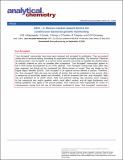ODX : a fitness tracker-based device for continuous bacterial growth monitoring
Abstract
Continuous monitoring of bacterial growth in aqueous media is a crucial process in academic research as well as in the biotechnology industry. Bacterial growth is usually monitored by measuring the optical density of bacteria in liquid media, using benchtop spectrophotometers. Due to the large form factor of the existing spectrophotometers, they cannot be used for live monitoring of the bacteria inside bacterial incubation chambers. Additionally, the use of benchtop spectrometers for continuous monitoring requires multiple samplings and is labor intensive. To overcome these challenges, we have developed an optical density measuring device (ODX) by modifying a generic fitness tracker. The resulting ODX device is an ultraportable and low-cost device that can be used inside bacterial incubators for real-time monitoring even while shaking is in progress. We evaluated the performance of ODX with different bacterial types and growth conditions and compared it with a commercial benchtop spectrophotometer. In all cases, ODX showed comparable performance to that of the standard benchtop spectrophotometer. Finally, we demonstrate a simple and useful smartphone application whereby the user is notified when the bacterial concentration reaches the targeted value. Due to its potential for automation and mass production, we believe that the ODX has a wide range of applications in biotechnology research and industry.
Citation
Yallapragada , V V B , Gowda , U , Wong , D , O’Faolain , L , Tangney , M & Devarapu , G C R 2019 , ' ODX : a fitness tracker-based device for continuous bacterial growth monitoring ' , Analytical Chemistry , vol. 91 , no. 19 , pp. 12329-12335 . https://doi.org/10.1021/acs.analchem.9b02628
Publication
Analytical Chemistry
Status
Peer reviewed
ISSN
0003-2700Type
Journal article
Description
G.C.R.D. acknowledges funding from the European Union’s Horizon2020 research and innovation programme under Marie Skłodowska-Curie grant agreement No. 713654. M.T. and V.V.B.Y. acknowledge funding from the Health Research Board (MRCG2016-25) and Breakthrough Cancer Research.Collections
Items in the St Andrews Research Repository are protected by copyright, with all rights reserved, unless otherwise indicated.

